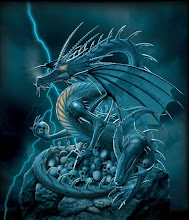For years and years the scientist have confirmed that the dinosaurs and their habitats, and whatever that lived within their time, are all finished, and what's left is their fossils. Now, this fish was thought to have been extinct since the end of the cretaceous period over 65 million years ago. Fossils of the coelacanth have been found that date back over 350 million years. At this time, scientists believe that no such fish still roam the deep of the sea.
Then, not long ago, a fisherman accidentally caught a live coelacanth off the coast of Africa in 1938. A second specimen was caught in 1952 off the coast of Comoros Islands near Madagascar. Scientists were baffled. A fish fossil, alive and roaming the sea near Africa? The matter was not left untended. A research party was formed, and they find that this 'Dinofish' has a lot of tale to tell. Especially when these scientists think that the coelacanth is the step of fish evolutioning into amphibians.
The most striking feature of this "living fossil" is its paired lobe fins that extend away from its body like legs and move in an alternating pattern, like a trotting horse. Other unique characteristics include a hinged joint in the skull which allows the fish to widen its mouth for large prey; an oil-filled tube, called a notochord, which serves as a backbone; thick scales common only to extinct fish, and an electrosensory rostral organ in its snout likely used to detect prey.
Ceolacanths are opportunistic feeders, eating just about anything they can find and fit in their mouth. They possess hinges in their skulls that allow them to consume very large prey. Their diet is believed to consist mainly of squid, eels, small sharks, and other animals that are found in their deep sea habitats. They hunt their prey near deep underwater volcanic slopes and can frequently be seen swimming with their heads down. They have even been seen swimming upside down and backwards. Researchers believe that this behavior allows them to use a special organ called a rostral gland to help them locate their prey. Once located, their meal is usually swallowed whole. Since food can be scarce at these great depths, scientists believe that the coelacanth has the ability to slow down its metabolism. This allows the fish to go for long periods of time without eating. This may be part of the reason they have survived so long and outlived their other prehistoric cousins. In their natural habitat, they are believed to live about 60 years.
Reproduction
Coelacanths give birth to live young, known as "pups". There are usually between 5 and 25 pups born at any given time. These young coelacanth pups are fully formed and capable of surviving on their own as soon as they are born. Their gestation time is 13 months, and it is believed that ceolacanths are unable to reproduce until they are 20 years old. Beyond that, very little is known about the reproductive habits of this elusive creature.
Dwellings
In 1989, the coelacanth was declared an endangered species by the international community. Their current world population is believed to be fewer than 500 animals. This means that without protection, this prehistoric animal that has survived for over 350 million years could be wiped out in our lifetime.
For more information, visit Dinofish.com








